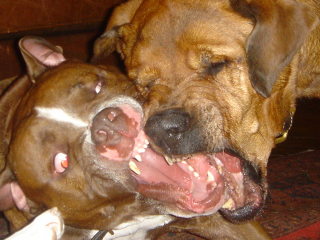Fighting

"He fights all the time! He's trying to kill other dogs!"
The fury and noise of a dogfight can be quite scary for onlookers, especially the dogs' owners. In fact, nothing upsets owners more than a dogfight. Consequently, owners must strive to be objective when assessing the seriousness of a dogfight. Otherwise, a single dogfight can put an end to their dogs' socialization. In most cases, a dogfight is highly stereotyped, controlled, and relatively safe. With appropriate feedback from the owner, the prognosis for resolution is good. On the other hand, irrational or emotional feedback, besides being upsetting for the owner, can exacerbate the problem for the dog.
It is extremely common for dogs, especially adolescent males, to posture, stare, growl, snarl, snap, and maybe fight. This is not "bad" dog behavior, but rather reflects what dogs normally do. Dogs do not write letters of complaint or call their lawyers. Growling and fighting, however, almost always reflect an underlying lack of confidence, characteristic of male adolescence. Given time and continued socialization, adolescent dogs normally develop confidence and no longer feel the need to continually prove themselves. To have the confidence to continue socializing a dog that has instigated a fight, the owner must convince herself that her "fighting dog" is not dangerous. A dog may be obnoxious and a royal pain, but this does not mean he would hurt another dog. Whereas growling and fighting are normal developmental behaviors, causing harm to other dogs is decidedly abnormal and unaceptable.
First, you need to ascertain the severity of the problem. Second, you need to make sure you react appropriately when your dog fights, and give appropriate feedback when he doesn't.
To know whether or not you have a problem, establish your dog's Fight-Bite Ratio. To do this you need to answer two questions: How many times has your dog been involved in a full-contact fight? And in how many fights did the other dog have to be taken to the veterinarian?
Ten-to-Zero is a common Fight-Bite Ratio for one- to two-year-old male dogs, that is, ten full-contact fights with opponents taking zero trips to the vet. We do not have a serious problem here. Obviously the dog is not "trying to kill" the other dog, since he hasn't caused any injury in ten fights. The dog would have caused damage if he had meant to. Moreover, on each occasion, the dog adhered to the Marquis of Dogsberry Fighting Rules by restricting bites to the other dog's scruff, neck, head, and muzzle. Surely, there is no better proof of the effectiveness of bite inhibition than, when in a fighting frenzy, one dog grasps another by the soft part of his throat and yet no damage is done.
This is not a dangerous dog. He is merely socially obnoxious in the inimitable manner of male adolescents. Yes, the dog is a bit of a pain, but he has wonderful bite inhibition (established during puppyhood) and has never injured another dog. Solid evidence of reliable bite inhibition — ten fights with zero bites while adhering to fighting rules — makes it extremely unlikely that this dog will ever harm another dog.
Fights are bad news, but they usually provide good news! As long as your dog never harms another dog, each fight provides additional proof that your dog has reliable bite inhibition. Your dog may lack confidence and social grace, but at least his jaws are safe. He is not a dangerous dog. Consequently, resolution of the problem will be fairly simple. Of course, you still have an obnoxious dog in dire need of retraining, since your dog is annoying other dogs and owners just as much as he annoys you. Contact the Association of Pet Dog Trainers to find a Fiesty Fido, Difficult Dog, or Growl Class.
On the other hand, if your dog has inflicted serious wounds to the limbs and abdomen of his opponents in just one of his fights, then you have a serious problem. This is a dangerous dog, since he has no bite inhibition. Obviously, the dog should be muzzled whenever on public property. The prognosis is poor, treatment will be complicated, time-consuming, potentially dangerous, requiring expert help, and certainly with small guarantee of a positive outcome. No dog problem presents such a marked contrast between prevention and treatment.
An adult fighter with no bite inhibition is the very hardest dog to rehabilitate, but prevention in puppyhood is easy, effortless, and enjoyable: simply enroll your puppy in puppy classes and take him to the park regularly. Do not wait for your adolescent dog to get into a fight to let him know you don't like it. Instead, make a habit of praising and rewarding your puppy every time he greets another dog in a friendly fashion. I know it may sound a little silly — praising your harmless, wiggly four-month-old male pup and offering a food treat every time he doesn't fight — but it's the best way to prevent fighting from becoming a serious problem.
Adapted from AFTER You Get Your Puppy by Dr. Ian Dunbar




